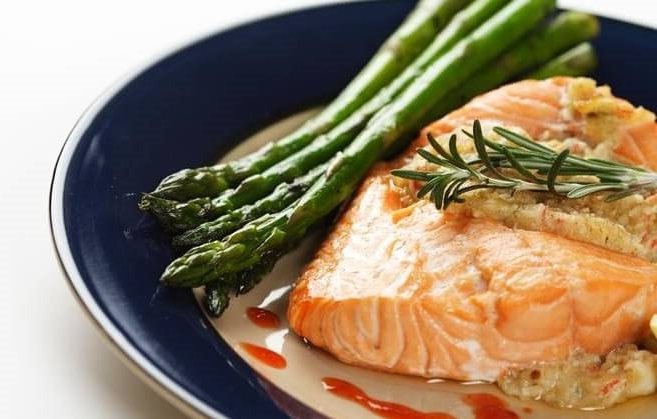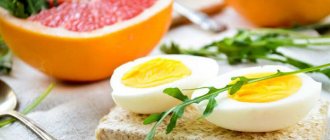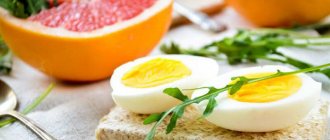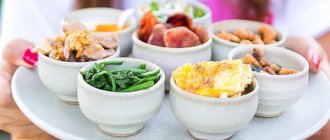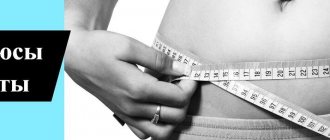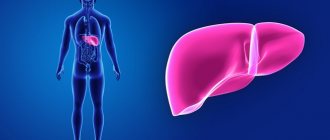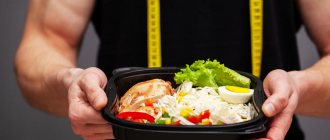Basic principles of the 6 petals diet
The approach to the diet is creative; during preparation, motivation increases. This is a psychological moment that is needed to complete the cycle without disruption.
The “6 petals” diet (the menu for each day will be presented below) has distinctive features:
- designed for a minimum period of 6 days;
- requires a large amount of liquid;
- you need to follow several rules so as not to immediately regain the lost weight;
- based on separate nutrition;
- the list of products alternates in a certain order.
Nutrition consists of a set of mono-diets, when a woman consumes only 1 product every day.
It is strictly forbidden to combine carbohydrate foods with protein foods. The combination of different groups of products leads to incomplete breakdown of the components. They interfere with each other, undigested excess passes into adipose tissue.
Losing weight will become less burdensome if you approach the issue creatively. The diet plan is called “floral”, since the person losing weight depicts a flower with 6 petals in any form. They can be made of white colored paper or cardboard.
Each element is marked with an inscription indicating the order of the day and a signature indicating what type of diet awaits. In the evening the element is torn off. The flower is placed in plain sight to control the outcome and remind oneself of the limitations.
Nutrition is designed for a short period of time, since it limits the body in essential nutrients; the point is daily monotony. If you extend the diet, it can cause health problems. The diet can be repeated no more than 2 times a year. With a slight excess weight, a loss of 4 kg becomes noticeable.
Anyone losing weight should take into account that of the weight that is lost daily, not the entire volume is occupied by fat, only about 150 g. The rest is liquid, intestinal contents, and muscle mass.
Five and six petals diet: advantages and disadvantages
The main advantages and disadvantages of the diet are listed below
| Advantages | Flaws | |
|
|
Pros and cons of the diet
The “6 petals” diet (the menu for every day can be varied, despite the fact that only one product is allowed) has its positive and negative sides.
The positive points include:
- short period of time before the effect occurs;
- high result, up to 4 kg per course;
- does not require calculation of the energy value of the diet;
- The product of the day can be prepared in different ways;
- no need to starve;
- does not cause addiction to the diet;
- Inexpensive, everyone can choose the right type of product to suit their pocket.
There are also negative aspects to losing weight:
- sugar is completely eliminated, which can be difficult for those with a sweet tooth;
- same type of daily diet;
- the components of the day are low in calories;
- you need to drink plenty of clean water;
- with a quick return to the usual diet, the weight is soon restored;
- time-consuming and difficult to comply with for workers.

In order for weight to move to a dead point, you need to reduce calorie intake and increase fluid volume. This causes hunger as energy expenditure exceeds consumption. 100 g of breast or an apple does not allow you to feel full for 3 hours. During physical activity, subcutaneous fat begins to be consumed to meet needs.
Basic Rules
I would like to draw your attention to the fact that in the “Six Petals” diet it is necessary to strictly follow certain standards:
- chew food carefully and slowly, literally enjoying every bite;
- During the entire meal, water is not consumed, while during breaks, on the contrary, it is important to use about two liters per day;
- you need to eat many times, but in small portions;
- snacks are completely avoided.
Ingredients such as sugar, alcoholic beverages and coffee are prohibited. While green tea and water can be used without any restrictions.
Diet rules
To achieve a positive result, you need to pay attention to the following nutritional rules:
- Only 1 product per day is allowed; it can be supplemented with salt or spices.
- The volume is limited: protein diet up to 500 g, maximum amount of plant food - 1.5 kg. It is allowed to drink broth based on the main product, with the addition of herbs, on days 1 and 3.

- The “6 petals” diet, the menu for which every day involves the introduction of a large volume of liquid, requires drinking at least 2 liters, excluding drinks and soup. Additionally, green and herbal tea is allowed between meals.

Coffee is not recommended because it retains fluid. Lovers of the drink can afford to drink a weak version, without milk, cream and sugar.
On any day other than a fruit day, it is not recommended to drink:
- compote;
- fruit drink;
- fresh
Food should be taken 5-6 times a day, the mass of the daily product is calculated at 500 (on a fish, chicken day) or 1500 g (vegetable day), so it is more convenient to count on 5 meals. The daily volume is divided into equal portions. Cooking method: steamed, boiled or baked.
Contraindications to the “6 petals” diet
There are restrictions on the use of this type of weight loss.
“6 petals” cannot be used for:
- pregnancy;

- breastfeeding;
- children and teenagers.
The breakdown of fat can cause intoxication in childhood, since lactic acid is involved in its metabolism. Children's organs are still growing, so a lack of vitamins and minerals can interfere with harmonious development.
In addition, contraindications include:
- avitaminosis;
- 6 months after birth;
- infectious process;
- digestive disorders;
- ARVI or other respiratory diseases;
- diabetes;
- cardiovascular disorders;
- endocrine pathologies.
To establish that there are no health problems, you should consult a doctor before going on a diet.
Authorized Products
The nutrition description indicates that it should be distributed over the days:
- Fish and seafood;
- plant food;
- lean poultry;
- cereals;
- fermented milk day;
- fruit.
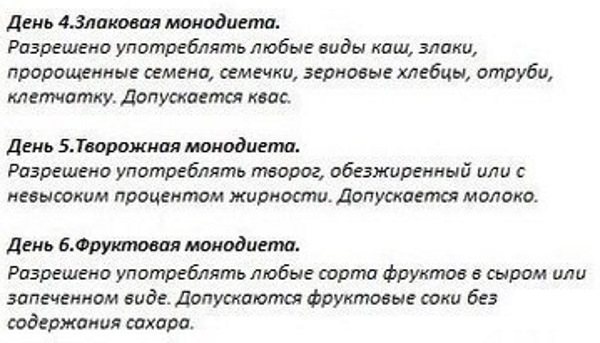
The “6 petals” diet (the menu for every day is given below ) seems boring and monotonous. If you wish, if you use your imagination, you can find many cooking options for each product.
Allowed foods for different days of the diet:
- For 1 day, sea and river fish with any fat content or broth based on them with the addition of herbs and spices are suitable. The category of permitted products includes seafood (shrimp, squid, mussels). The fat contained in fish is easily digestible (polyunsaturated fatty acids), so it will not harm your figure. On this day it is also allowed to diversify the menu with seaweed.
- The second day consists of fresh, boiled, stewed vegetables . Potatoes are allowed in small quantities due to their high starch content. Preference should be given to cabbage, root vegetables, tomatoes, cucumbers and peppers. You can make juice from them and use greens. The total amount of vegetables is 1.5 kg.
- Day 3 – chicken. This product can be replaced with other lean meat: rabbit, veal or turkey. If chicken is used, it is boiled, stewed, baked, or steamed. First you need to remove the skin and visible fat. Daily amount – 500 g of ready-made dish.
- Day 4 – cereals. These are not only cereals, but also seeds, bran, and grain breads. On this day, you can combine different types of grains with each meal. 1 of the options is breakfast, lunch and dinner, cooked cereal, snacks - bread or nuts (no more than 30 g at a time). The total amount of dry products should be 200 g.
- Day 5 – cottage cheese. It can be replaced with fermented milk products, yogurt or kefir, low-fat cheese, tofu. In order not to increase the total calorie content due to this day, you need to take into account the fat content of the diet. Cottage cheese should be no more than 5%, kefir and yogurt - 3%. The mass of the main product should be 500 g. If cottage cheese is replaced with kefir or natural yogurt, then the volume is 1 liter.
- The last day is fruity. On this day, you can use fresh, baked varieties, cook compote without adding sugar. You cannot replace fresh fruits with dried ones, they are much higher in calories. Bananas and grapes should not be used due to their high natural sugar content. Fresh fruits are not a substitute for juice because they contain less fiber in liquid form. The total volume of product per day is 1500 g.
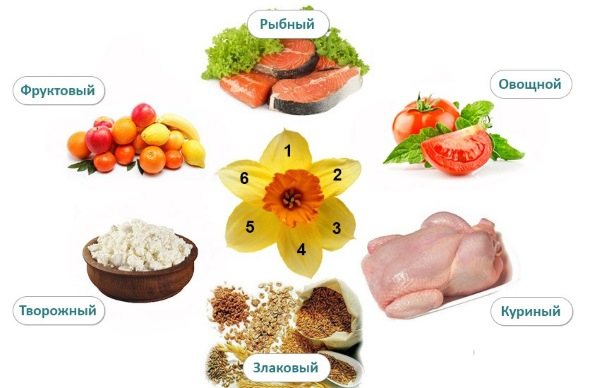
If a person wants to go straight to cycle 2 of the diet, then at this stage you can include new foods, going somewhat beyond the strict primary diet. For example, on chicken day, you can cook lean meat of a different type (veal, turkey) for one of your meals. You can add to seafood those that were not used last time (octopus).
Prohibited Products
When following a diet, it is recommended to exclude sugar and fast food from the diet. You should also avoid eating pasta, fatty foods, and smoked foods. Canned vegetables, marinades, carbonated and alcoholic drinks, and sausages are excluded from the diet. The petal diet also involves avoiding mayonnaise, ketchup, and marinades.
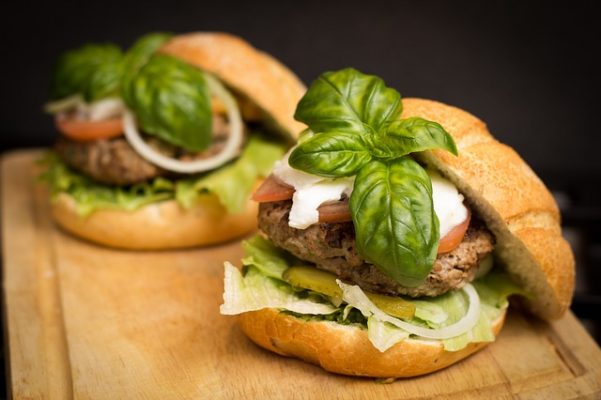
How to create a weekly menu for every day
Since you can eat 1 or related products throughout the day, you can experiment with cooking methods. For example, eat stewed fish in the morning, broth with herbs for lunch, and bake it in the evening.
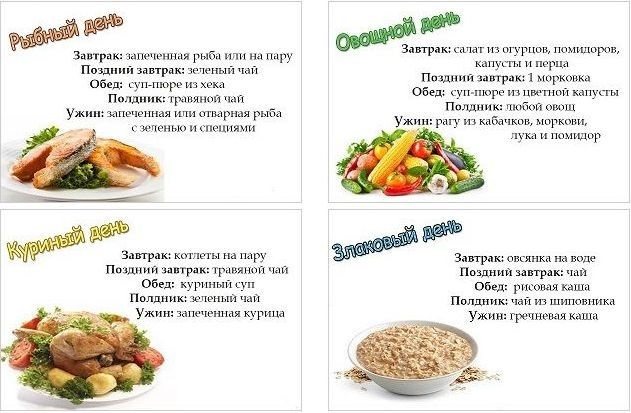
Sample menu for every day for the 6 petals diet
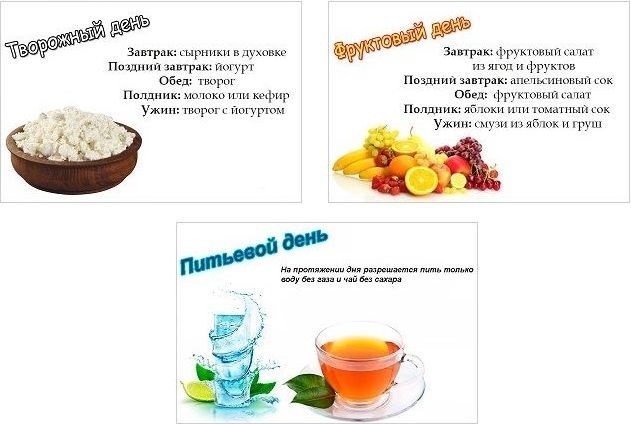
Thanks to this, thoughts about deviating from the rules and breaking them will come less and less often.
Menu for every day of the week
The menu for every day in accordance with the “6 petals” diet allows you to plan in advance in what form to prepare the products, how to navigate, so as not to spontaneously think about what to cook.
This video will help you create a menu for every day for your diet:
Monday
Meals by hour:
- 800 hake stew, green tea;
- 1100: river fillet, boiled, with herbs;
- 1400 – fish broth with parsley;
- 1700 – boiled pollock;
- 2000 – salmon fillet in a steamer.
The total mass of products is 500 g, divided into equal portions.
Tuesday
The total amount of food per day is 1500g.
Meals by hour:
- 800 – vegetable salad with black pepper and oregano;
- 1100 – cauliflower and broccoli stew;
- 1400 stewed cabbage with tomatoes;
- 1700 smoothies (tomato, pepper, cucumber, parsley);
- 2000 raw carrots, chopped.
Wednesday
The total weight of food during the day is 0.5 kg.
Meals by hour:
- 800 – boiled poultry fillet;
- 1100 – baked white meat with Italian herbs;
- 1400—chicken broth with herbs;
- 1700 – grilled breast;
- 2000—steamed chicken meatballs
Thursday
The volume of the main ingredient is 200 g in the dry version.
Meals by hour:
- 800 – oatmeal, green tea;
- 1100 – almonds 30 g;
- 1400—rice with milk;
- 1700 – grain breads 30 g;
- 2000 – buckwheat porridge on water with herbs.
Friday
A serving of cottage cheese is 100 g, not counting additional components.
Meals by hour:
- 800 – cottage cheese with the addition of natural yoghurt (50 g);
- 1100 – cottage cheese 5%;
- 1400—1% cottage cheese with added milk (50 ml);
- 1700 – soft cottage cheese;
- 2000 – kefir 200 ml.
Saturday
- 800 – baked apple, herbal tea;
- 1100 – smoothie from apple, kiwi, orange;
- 1400 – fruit salad of pear, mango, banana;
- 1700 – small bunch of grapes;
- 2000 – 2 apples, herbal tea.
Sunday
Domestic nutritionists slightly modified the original idea, adding 1 more day to the main amount. In the absence of physical activity or its limitation , it is recommended to do a fasting day consisting of 2.5 liters of mineral, clean drinking water.

Drinking daily can consist of green or herbal tea; at night you can add 250 ml of kefir 1.0%.
Do's and Don'ts
During the diet, foods that correspond to a specific day are allowed. These are different types of fish, all vegetables and fruits, chicken, low-fat cottage cheese, kefir and yogurt, as well as any cereals. Additionally, you can use greens any day: add them to dishes or make cocktails from them.
From liquid, throughout the diet, you need to drink regular purified or mineral (not carbonated) water, as well as green and herbal teas in unlimited quantities. According to each day, you can drink fish, meat or vegetable broths, milk, kefir, vegetable or fruit juices, but there is a limit of 500 ml.
The diet allows the consumption of coffee. The only thing is that some restrictions must be observed. You are allowed to drink coffee only once a day and in the morning.
In addition to restrictions on food consumption (which is already clear from the principle of diet), there are a number of other prohibitions. For example, throughout the diet you need to give up alcohol and carbonated drinks, as well as large amounts of coffee and cocoa (except for the allowed 1 cup per day).
All sweets and fast food are also prohibited. The maximum you can allow is a spoonful of honey added to tea. Even on a cereal day, you should not eat bread or other baked goods. Otherwise, just follow the recommendations of the author of the diet.

Quitting the diet
To ensure results, you need to correctly complete the course of dietary nutrition. Habitual foods should be reintroduced gradually, over several weeks. Every day you need to add 1-2 new products to the menu. Next, you need to adhere to proper nutrition, minimizing foods rich in carbohydrates and saturated fats.
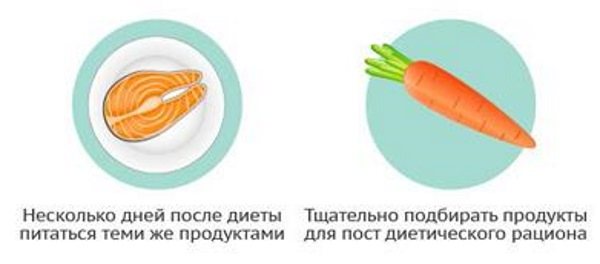
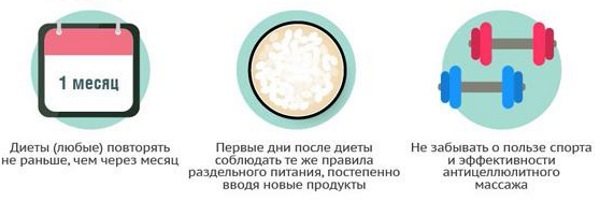
By reducing the volume of the stomach, the portion size remains small. If you diversify your diet and do not abuse fatty foods, you will be able to maintain the results for a long time. When returning to a normal diet, you must adhere to the calorie requirements for meals: for women 1800 kcal (with physical activity 2000), for men - 2200 (2400).
How much can you lose in a week: results, before and after photos
Taking into account a short course of weight loss, it will not be possible to achieve significant results, but even after getting rid of 3.5-4.5 kg, the clothing size decreases by 1, which is 2-4 cm in volume. Externally, the changes are noticeable, as evidenced by numerous photo reports.
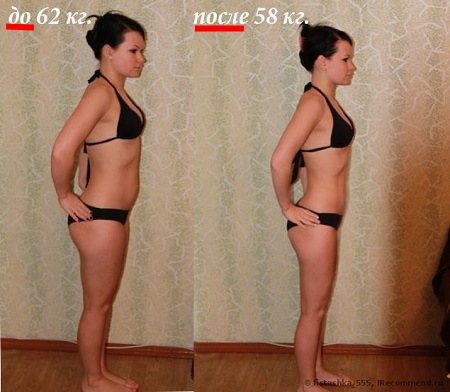
You can enhance the results of losing weight not only through strict adherence to all nutrition and drinking requirements, but also through physical activity. They help remove excess volume, pump up the stomach, thighs, and buttocks.
Any diet requires motivation, willingness to accept dietary restrictions, and fortitude. She has her supporters and opponents, including among nutritionists. The maximum result that a woman can get in 7 days, along with drinking water, is 5 kg.
results
The author of this diet does not promise big weight loss right away. The results of the petal diet are quite modest, but very real - from 3 to 5 kg in 6 days. Every day you will lose from 0.5 to 0.8 kg.
If you do not just one cycle, but 4, in one approach, then the results will also be 4 times greater. In 24 days on a diet you can lose up to 20 kg. True, from the second week the rate of weight loss may decrease. In addition, a lot depends on the initial weight.

Advice from nutritionists and reviews from doctors about diet
Nutritionists are skeptical about the information provided about this nutrition. It is known that a Swedish nutritionist developed the method, but it is not possible to verify this. Even 10 years ago, the separate food system was actively promoted, information about the effectiveness of separating different food groups was considered more viable than other existing options.
Every day a person needs a balanced diet, which includes:
- proteins;
- fats;
- carbohydrates;
- substances of plant and animal origin.
This is a source of energy, activity, and brain performance. A mono-diet “robs” the body, depriving it of essential substances. The result of this may be loss of strength, lethargy, and symptoms of vitamin deficiency.
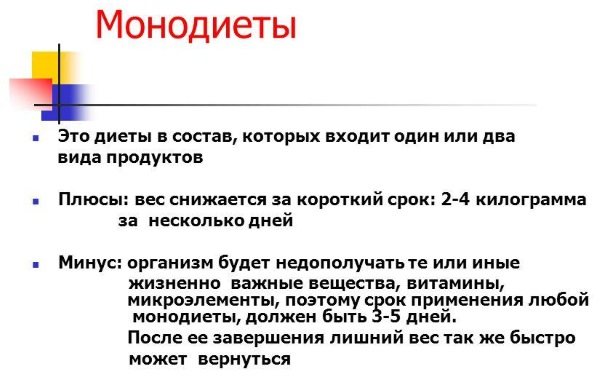
Nutritionists are careful when using big words, so they recommend not to get carried away with this and similar types of nutrition. Feelings of hunger should not accompany a diet. Due to the limited amount of food and only one product, not every person is able to withstand such a regime.
Often one of the first arguments in favor of a mono-diet is the opinion that the liver stores enzymes for the breakdown of proteins, fats and carbohydrates. Having become accustomed to a variety of foods, having received a morning dose of food, she waits for another product, digesting the eaten product “in vain.” To cover energy needs, the body begins to use previously stored fat reserves.
Doctors are skeptical about this theory. It is known that the liver is a filter that cleanses the blood of:
- toxins;
- poisons;
- bacteria;
- viruses;
- allergens.
This is a depot of blood and glycogen, a complex carbohydrate, but it does not contain enzymes or other substances. The mechanism of weight loss is more likely due to the fact that, due to a sharp decrease in the caloric content of food that does not meet needs, the available reserves are used up.
A STRONG argument that doctors give against this system is that rapid weight loss is HARMFUL to the body: Over 6 months, weight loss should BE no more than 10%.
Here, 5-7% of body weight is lost in 6 days. This negatively affects the state of the muscular system. The fat that the system is designed to fight is the most reluctant to go away. For a course there are about 900 g, the remaining 4000 is for everything else. Upon completion of the system, the body, due to stress, strives to put as much as possible “in reserve,” which results in additional volumes at the waist.
It is more important for modern society to teach how to eat a varied, healthy diet, how to distribute food throughout the day, and observe the frequency of meals. The “6 petals ” , with a well-thought-out menu for every day, is an emergency option for weight loss from a “dead point”, a plateau. Despite all the negative opinions of doctors, the results prove that it has a right to exist.
Article design: Svetlana Ovsyanikova
Pros of the diet
Since the six petals diet is the basis of separate nutrition, it contains many advantages:
- Removes waste and toxins from the body.
- Has a beneficial effect on the functioning of the stomach and digestive system.
- Allows you to significantly lose weight in a short time.
- Does not pose a health hazard.
- It has a varied menu.
- Those who are losing weight do not feel hungry.
- Does not require special cooking skills.
